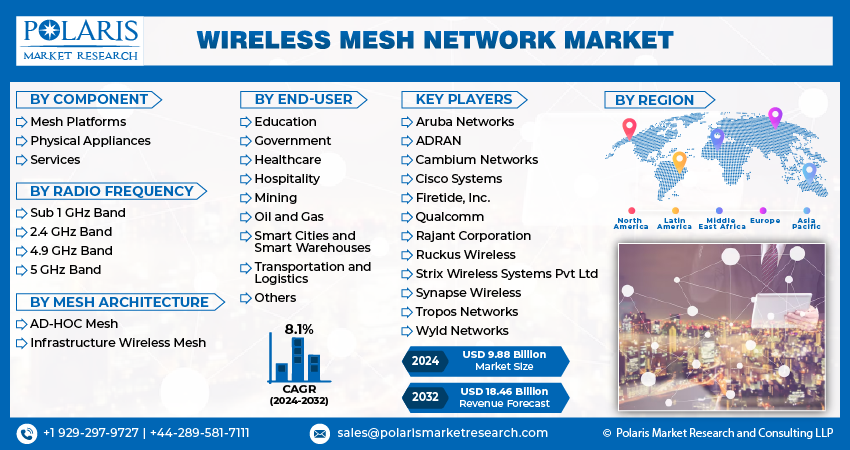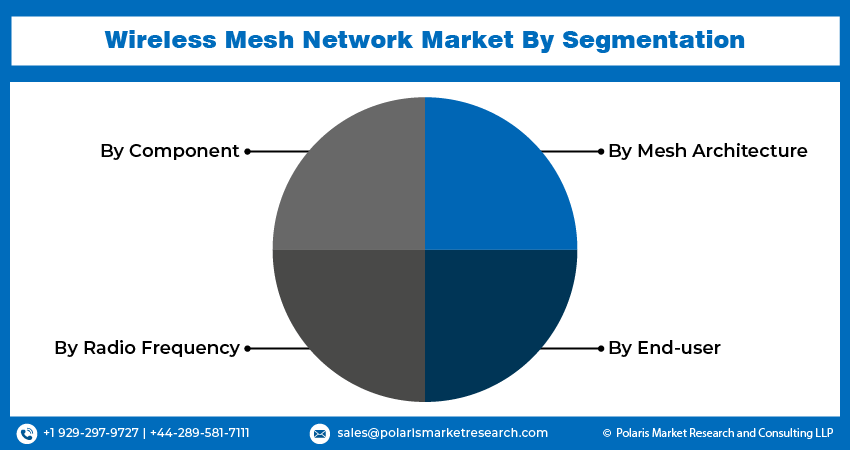
Wireless Mesh Network Market Share, Size, Trends, Industry Analysis Report
By Component (Physical Appliances, Mesh Platforms, Services); By Radio Frequency; By Mesh Architecture; By End-User; By Region; Segment Forecast, 2025 - 2034
- Published Date:May-2025
- Pages: 152
- Format: PDF
- Report ID: PM1406
- Base Year: 2024
- Historical Data: 2020-2023
The global wireless mesh network market was valued at USD 9.72 billion in 2024 and is anticipated to grow at a CAGR of 8.0% from 2025 to 2034. Growth is fueled by increasing deployment in smart cities, IoT applications, and industrial automation.
A wireless mesh network (WMN) is a type of communication network that connects devices using radio waves, rather than regular wired connections. In a WMN, each device acts as both a transmitter and receiver, allowing data to be transmitted between devices in a decentralized manner. This creates a web-like structure, with multiple interconnected nodes or access points that allow for efficient communication and data transfer across the network. The lack of centralized control makes WMNs stronger and more adaptable to changing network conditions, making them ideal for several end use applications.
The growing adoption of smart connected devices, combined with the reduction of connected device costs, is primarily driving the growth of the wireless mesh network market. The growing demand for bandwidth supports the growth of the wireless mesh network market. Wireless mesh networks are becoming more popular as they offer a cost-effective and flexible alternative to traditional wired networks, especially in areas where it is difficult or expensive to lay down cables.

To Understand More About this Research: Request a Free Sample Report
Additionally, the growing need for smart city initiatives, IoT applications, and public safety communications is also fueling the adoption of wireless mesh networks. The market is expected to be driven by various factors such as the increasing demand for high-speed internet connectivity, rising number of connected devices, and the need for secure and reliable communication networks.
Moreover, the advancement in technologies such as 5G, IoT, and AI is also expected to drive the market growth. For instance, 5G services offers higher bandwidth and lower latency, which enables faster data transfer rates and supports mission-critical applications such as autonomous vehicles and smart grids. Similarly, IoT devices generate vast amounts of data that require fast and secure transmission, which can be achieved through wireless mesh networks.
However, privacy concerns and data security are expected to hinder the growth of the wireless mesh network market during the forecast period. Growing demand from emerging economies, as well as increased adoption by small and medium-sized businesses, are expected to provide numerous growth opportunities in the coming years.

Growth Drivers
- The growing adoption of smart connected devices drives the growth of the wireless mesh network market.
The increasing popularity and widespread adoption of smart connected devices is a significant factor driving the growth of the market since smart devices such as smartphones, tablets, wearables, and home appliances are becoming popular, and they all require connectivity to function optimally. Wireless mesh networks provide a reliable and efficient way to connect these devices, allowing them to communicate with each other and exchange data seamlessly. Also, the rise of IoT (Internet of Things) technology has led to an explosion in the number of connected devices, further fueling the demand for wireless mesh networks. With more devices requiring connectivity, businesses and individuals need robust and scalable networking solutions that can accommodate this growing number of devices.
Wireless mesh networks offer a flexible and cost-effective solution, enabling organizations to expand their network coverage without the need for expensive infrastructure upgrades. In addition, the advancement of technologies like Wi-Fi 6 and 5G is also expected to drive the growth of the wireless mesh network market, providing faster speeds and lower latency, which will enable new use cases and applications for wireless connectivity. Overall, the surging adoption of smart connected devices creates a intense need for wireless mesh networks, making it a key driver of the market's growth.
Report Segmentation
The market is primarily segmented based on component, radio frequency, mesh architecture, end-user, and region.
|
By Component |
By Radio Frequency |
By Mesh Architecture |
By End-user |
By Region |
|
|
|
|
|
To Understand the Scope of this Report: Speak to Analyst
By Component Analysis
- The physical appliances segment held the largest market share in 2024.
The physical appliances segment, which includes devices such as routers, switches, and access points, held the largest market share in 2024. This is because these devices are essential components of a wireless mesh network infrastructure, providing the necessary connectivity and coverage to enable communication between devices. In a wireless mesh network, multiple access points or nodes work together to create a web-like structure, allowing data to be transmitted wirelessly between devices. Physical appliances play an important role in establishing and maintaining this network by providing the hardware necessary for each node to communicate with the others.
Also, physical appliances offer several advantages over software-based solutions when it comes to building a wireless mesh network. For example, they provide greater range and reliability, as well as better performance in high-density environments. They also offer enhanced security features, such as built-in firewalls and intrusion detection systems, to protect against unauthorized access and ensure secure communication within the network. Thus, the dominance of physical appliances in the wireless mesh network market reflects their importance in creating a robust and reliable network that meets the needs of modern organizations.
By Mesh Architecture Analysis
- The AD-HOC mesh segment is estimated to grow significantly over the forecast period.
The AD-HOC mesh segment is expected to experience substantial growth during the forecast period with regard to the wireless mesh network market because of the increasing demand for flexible and self-organizing networks that can adapt to changing network conditions and provide seamless connectivity. Ad-hoc meshing allows nodes to dynamically form and maintain networks without the need for a centralized infrastructure, making it an attractive option for applications such as IoT, rural broadband, and emergency response situations. Also, advancements in technologies like artificial intelligence and machine learning are enabling more efficient path selection, further improving the performance of ad-hoc mesh networks.

Regional Insights
- North America region dominated the wireless mesh network market in 2024.
The North American wireless mesh network market dominated the share owing to the increasing demand for reliable and high-speed connectivity, the growing adoption of smart city initiatives, and rising investments in IoT technologies. Along with this, the existence of advanced infrastructure and favorable government policies supporting the deployment of wireless networks further fueled the growth of the wireless mesh network market in North America.
- For instance, the Federal Communications Commission (FCC) has implemented policies that promote the use of unlicensed spectrum for wireless networking, which has encouraged companies to invest in wireless mesh technology.
Also, the presence of major industry players such as Google, Facebook, and Microsoft, who are actively involved in developing and deploying wireless mesh networks, contributed to the region's dominance. Overall, the combination of these factors contributed to the dominance of the North American region.
The Asia Pacific wireless mesh network market is witnessing significant growth, driven by various factors such as the increasing demand for good connectivity, expanding IoT ecosystem, and supportive government initiatives. China, India, Japan, and South Korea are among the key countries driving the regional market growth, owing to their large populations, rapid urbanization, and growing need for smart city projects. Governments in the region are also promoting the adoption of wireless mesh networks through initiatives like smart city projects, rural broadband initiatives, and funding programs for startups working on wireless mesh technology.

Key Market Players & Competitive Insights
Manufacturers in the market are engaged in various activities to enhance their product offerings and expand their customer base. They are continuously innovating and introducing new products and solutions that cater to the evolving needs of consumers. For instance, companies like Qualcomm and Intel are focusing on developing chipsets that support mesh networking capabilities, while firms like Linksys and Netgear are launching new routers and access points that are compatible with mesh networks. In addition, many manufacturers are collaborating with software providers to develop integrated solutions that combine hardware and software components, providing users with seamless and secure connectivity.
Some of the major players operating in the global market include:
- Aruba Networks
- ADRAN
- Cambium Networks
- Cisco Systems
- Firetide, Inc.
- Qualcomm
- Rajant Corporation
- Ruckus Wireless
- Strix Wireless Systems Pvt Ltd
- Synapse Wireless
- Tropos Networks
- Wyld Networks
Recent Developments
- In June 2024, NETGEAR's new WiFi 7 Orbi 770 Mesh System and Nighthawk RS300 Router were launched. These products provided enhanced multi-gig speeds, low latency, and robust security, offering consumers cutting-edge performance for home networking needs
- In September 2023, Wyld Networks launched a new mobile mesh networking technology and content delivery platform, Wyld Mesh and Fusion.
- In October 2023, Adran launched next-generation Wi-Fi 6, 6E, and 7 service delivery gateways (SDGs) for optimized in-home connectivity, the SDG 8600 and 8700 Series.
Wireless Mesh Network Market Report Scope
|
Report Attributes |
Details |
|
Market size value in 2025 |
USD 10.55 Billion |
|
Revenue Forecast in 2034 |
USD 21.9 Billion |
|
CAGR |
8.0% from 2025 – 2034 |
|
Base year |
2024 |
|
Historical data |
2020 – 2023 |
|
Forecast period |
2025 – 2034 |
|
Quantitative units |
Revenue in USD Billion and CAGR from 2025 to 2034 |
|
Segments Covered |
By Component, By Radio Frequency, By Mesh Architecture, By End-User, By Region |
|
Regional scope |
North America, Europe, Asia Pacific, Latin America, Middle East & Africa |
|
Customization |
Report customization as per your requirements concerning countries, regions, and segmentation. |
FAQ's
The global key Wireless Mesh Network market players include Aruba Networks, ADRAN, Cambium Networks, Cisco Systems, Firetide, Inc., Qualcomm, Rajant Corporation
The global wireless mesh network market is expected to grow at a CAGR of 8.0% during the forecast period.
Wireless Mesh Network Market report covering key segments are component, radio frequency, mesh architecture, end-user, and region.
The key driving factors in Wireless Mesh Network Market are growing adoption of smart connected devices drives the growth of the wireless mesh network market
Wireless Mesh Network Market Size Worth USD 21.9 Billion By 2034
